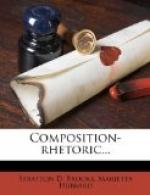Webster could address a bench of judges;
Everett could charm a
college; Choate could delude
a jury; Clay could magnetize a senate,
and Tom Corwin could hold
the mob in his right hand; but no one
of these men could do more
than this one thing.
—Wendell Phillips.
We might as well decide the question now;
for we shall surely be
obliged to soon.
2. When the members of a compound sentence themselves contain commas, they should be separated from one another by semicolons.
As Caesar loved me, I weep for him; as
he was fortunate, I rejoice at
it; as he was valiant, I honor
him; but, as he was ambitious, I slew
him.
—Shakespeare.
3. The semicolon should be used to precede as, namely, i.e., e.g., viz.
Some adjectives are compared irregularly; as, good, bad, and little.
4. When a series of distinct statements all have a common dependence on what precedes or follows them, they may be separated from each other by semicolons.
When subject to the influence of cold
we eat more; we choose more
heat-producing foods, as fatty
foodstuffs; we take more vigorous
exercise; we put on more clothing,
especially of the non-conducting
kinds—woolens.
+7. Rules for the Use of the Colon.+—1. The colon is used before long or formal quotations, before enumerations, and before the conclusion of a previous statement.
Old Sir Thomas Browne shrewdly observes:
“Every man is not only
himself. There have been
many Diogeneses and many Timons
though but few of the name.
Men are lived over again. The world
is now as it was in ages past.
There were none then, but there has
been one since, that parallels
him, and is, as it were, revived self.”
—George Dana Boardman.
Adjectives are divided into two general
classes: descriptive and
definitive adjectives.
The following members sent in their resignations:
Mrs. William M.
Murphy, Mrs. Ralph B. Wiltsie,
and Mrs. John C. Clark.
2. The colon is used to separate the different members of a compound sentence, when they themselves are divided by semicolons.
It is too warm to-day; the sunshine is
too bright; the shade, too
pleasant: we will wait
until to-morrow or we will have some one else
do it when the busy time is
over.
+8. Rules for the Use of the Period.+—1. The period is used at the close of imperative and declarative sentences.
2. All abbreviations should be followed by a period.
+9. Rule for the Use of the Interrogation Mark.+—The interrogation mark should be used after all direct questions.
+10. Rule for the Use of the Exclamation Mark.+—Interjections and exclamatory words and expressions should be followed by the exclamation mark. Sometimes the exclamatory word is only a part of the whole exclamation. In this case, the exclamatory word should be followed by a comma, and the entire exclamation by an exclamation mark.




